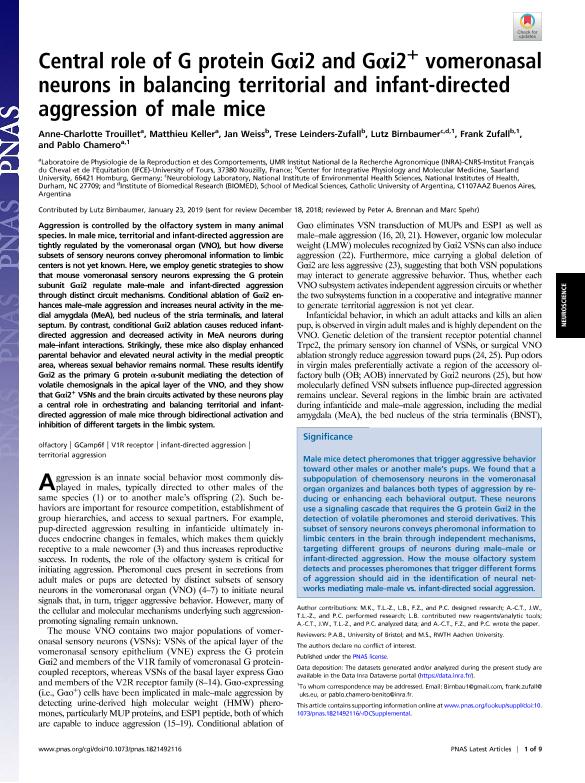Mostrar el registro sencillo del ítem
dc.contributor.author
Trouillet, Anne Charlotte
dc.contributor.author
Keller, Matthieu
dc.contributor.author
Weiss, Jan
dc.contributor.author
Leinders Zufall, Trese
dc.contributor.author
Birnbaumer, Lutz

dc.contributor.author
Zufall, Frank
dc.contributor.author
Chamero, Pablo
dc.date.available
2020-12-16T14:14:25Z
dc.date.issued
2019-03
dc.identifier.citation
Trouillet, Anne Charlotte; Keller, Matthieu; Weiss, Jan; Leinders Zufall, Trese; Birnbaumer, Lutz; et al.; Central role of G protein Gαi2 and Gαi2 + vomeronasal neurons in balancing territorial and infant-directed aggression of male mice; National Academy of Sciences; Proceedings of the National Academy of Sciences of The United States of America; 116; 11; 3-2019; 5135-5143
dc.identifier.issn
0027-8424
dc.identifier.uri
http://hdl.handle.net/11336/120565
dc.description.abstract
Aggression is controlled by the olfactory system in many animal species. In male mice, territorial and infant-directed aggression are tightly regulated by the vomeronasal organ (VNO), but how diverse subsets of sensory neurons convey pheromonal information to limbic centers is not yet known. Here, we employ genetic strategies to show that mouse vomeronasal sensory neurons expressing the G protein subunit Gαi2 regulate male-male and infant-directed aggression through distinct circuit mechanisms. Conditional ablation of Gαi2 enhances male-male aggression and increases neural activity in the medial amygdala (MeA), bed nucleus of the stria terminalis, and lateral septum. By contrast, conditional Gαi2 ablation causes reduced infantdirected aggression and decreased activity in MeA neurons during male-infant interactions. Strikingly, these mice also display enhanced parental behavior and elevated neural activity in the medial preoptic area, whereas sexual behavior remains normal. These results identify Gαi2 as the primary G protein a-subunit mediating the detection of volatile chemosignals in the apical layer of the VNO, and they show that Gαi2 + VSNs and the brain circuits activated by these neurons play a central role in orchestrating and balancing territorial and infantdirected aggression of male mice through bidirectional activation and inhibition of different targets in the limbic system.
dc.format
application/pdf
dc.language.iso
eng
dc.publisher
National Academy of Sciences

dc.rights
info:eu-repo/semantics/openAccess
dc.rights.uri
https://creativecommons.org/licenses/by-nc-sa/2.5/ar/
dc.subject
GCAMP6F
dc.subject
INFANT-DIRECTED AGGRESSION
dc.subject
OLFACTORY
dc.subject
TERRITORIAL AGGRESSION
dc.subject
V1R RECEPTOR
dc.subject.classification
Biología Celular, Microbiología

dc.subject.classification
Ciencias Biológicas

dc.subject.classification
CIENCIAS NATURALES Y EXACTAS

dc.title
Central role of G protein Gαi2 and Gαi2 + vomeronasal neurons in balancing territorial and infant-directed aggression of male mice
dc.type
info:eu-repo/semantics/article
dc.type
info:ar-repo/semantics/artículo
dc.type
info:eu-repo/semantics/publishedVersion
dc.date.updated
2020-11-25T16:38:03Z
dc.journal.volume
116
dc.journal.number
11
dc.journal.pagination
5135-5143
dc.journal.pais
Estados Unidos

dc.description.fil
Fil: Trouillet, Anne Charlotte. Universite de Tours; Francia. Centre National de la Recherche Scientifique; Francia
dc.description.fil
Fil: Keller, Matthieu. Universite de Tours; Francia. Centre National de la Recherche Scientifique; Francia
dc.description.fil
Fil: Weiss, Jan. Universitat Saarland; Alemania
dc.description.fil
Fil: Leinders Zufall, Trese. Universitat Saarland; Alemania
dc.description.fil
Fil: Birnbaumer, Lutz. Pontificia Universidad Católica Argentina "Santa María de los Buenos Aires". Instituto de Investigaciones Biomédicas. Consejo Nacional de Investigaciones Científicas y Técnicas. Oficina de Coordinación Administrativa Houssay. Instituto de Investigaciones Biomédicas; Argentina
dc.description.fil
Fil: Zufall, Frank. Universitat Saarland; Alemania
dc.description.fil
Fil: Chamero, Pablo. Universite de Tours; Francia. Centre National de la Recherche Scientifique; Francia
dc.journal.title
Proceedings of the National Academy of Sciences of The United States of America

dc.relation.alternativeid
info:eu-repo/semantics/altIdentifier/doi/http://dx.doi.org/10.1073/pnas.1821492116
dc.relation.alternativeid
info:eu-repo/semantics/altIdentifier/url/https://www.pnas.org/content/116/11/5135
Archivos asociados
